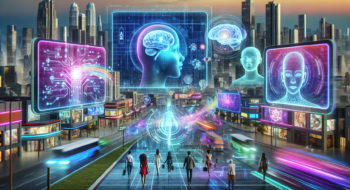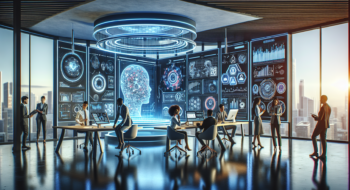As the ebbs and flows of the AI race continue to dominate the attention of business leaders, investors, and the media, one groundbreaking advancement is capturing the spotlight: Agentic AI. This innovation is set to empower human agency, unlocking new possibilities and redefining our interactions with technology. The convergence of Agentic AI and spatial computing promises to revolutionize industries by enhancing decision-making, personalizing experiences, and promoting creativity. As we delve deeper into these transformative forces, we will explore how they are reshaping the future and driving the next wave of progress in the digital landscape.
Empowering Human Agency: The Game-Changing AI Revolution Unleashed
In the world of technology, the term “revolution” gets tossed around a lot, but the fusion of Agentic AI and spatial computing might just fit the bill. Imagine a world where machines not only assist us but also empower our decisions, enhancing our human agency rather than diminishing it. This synergy could redefine how we interact with our digital environments, as well as with each other. So buckle up, folks; it’s time to dig into the layers of this exciting intersection!
The Rise of Agentic AI
Agentic AI refers to artificial intelligence systems designed to operate autonomously while still aligning with human objectives and ethical principles. Think of it as a highly intelligent assistant that understands not just your commands but your intentions. It learns and adapts over time, gaining insight into ways to enhance your decision-making process. This doesn’t just free up time; it amplifies the cognitive abilities of the user.
- Enhanced Decision-Making: Whether it’s in healthcare, finance, or any number of industries, Agentic AI can analyze vast sets of data, making informed decisions faster than any human could. This leads to opportunities for richer insights.
- Personalized Experiences: Imagine stepping into a retail store where your AI assistant knows your preferences better than your best friend! This level of personalization can be game-changing.
- Promoting Creativity: By handling mundane tasks, Agentic AI gives individuals the freedom to focus on creative endeavors, leading to breakthroughs in art, technology, and beyond.
The Role of Spatial Computing
Now, let’s talk about spatial computing. This burgeoning field blends the digital and physical worlds, enabling data to interact with the spatial dimensions of our personal and communal environments. With the rise of augmented reality (AR) and virtual reality (VR), spatial computing immerses users in a three-dimensional context that enhances engagement and comprehension.
Spatial computing equips us to visualize complex datasets, discover underlying patterns that may remain hidden in traditional formats, and interact with our environment in truly innovative ways. When paired with Agentic AI, the potential becomes limitless. Both technologies together can spawn an era of deeply integrated experiences that boast not only intelligence but a keen understanding of context, which is crucial for empowering human agency.
How the Partnership Works
Let’s explore some fascinating use cases where Agentic AI and spatial computing are already making waves:
- Healthcare: In a clinical setting, spatial computing can display 3D representations of complex human anatomy, while Agentic AI systems analyze historical patient data to suggest potential treatment pathways. The result? Doctors are informed by rich insights while they visualize their patient’s condition in a holistic manner.
- Education: Imagine students exploring ancient civilizations through immersive AR experiences, with Agentic AI providing personalized learning paths tailored to each student’s needs. This blend not only deepens understanding but makes learning feel like a grand adventure.
- Urban Planning: City planners can leverage spatial computing to create 3D models of urban landscapes. Agentic AI can then analyze data from numerous sources to forecast the impact of various planning decisions. This cooperative approach safeguards human agency while ensuring the development of thriving communities.
Empowering Human Agency in Decision-Making
At the heart of the convergence lies the promise of enhanced decision-making capabilities. Historically, many technological advancements have led to discussions of job displacement and reliance on machines, often at the expense of human skills. However, by embracing Agentic AI and spatial computing, we confront these challenges head-on, revealing how these innovations can bolster—rather than threaten—human agency.
This is a crucial paradigm shift. By employing these tools, we can assist individuals in making more informed decisions through collaboration rather than replacement. With intelligent systems that assess information and present options through a spatial interface, humans can maintain the final authority over decisions while enjoying the benefits of advanced analytics and powerful visualization tools.
Potential Challenges and Ethical Considerations
Of course, no revolution comes without its challenges. A crucial aspect of ensuring that human agency remains at the forefront lies in addressing ethical concerns. As we forge ahead into this brave new world of AI and spatial computing, we should be mindful of the following:
- Privacy: Agentic AI systems require data to function optimally. With the potential for vast amounts of sensitive information being collected and analyzed, robust privacy measures need to be established to safeguard individual rights.
- Bias: Just as AI algorithms can inadvertently be biased, spatial data may also reflect societal inequities. It’s vital to ensure that these systems are developed responsibly to promote inclusivity and fairness.
- Transparency: Users must understand how AI systems operate and how they arrive at recommendations. Transparency will ensure that people retain their agency and can make informed choices about adopting these technologies.
A Vision for the Future
The fusion of Agentic AI and spatial computing is not merely an extension of what technology can do; it is a radical transformation in how we experience the world around us. As we devise new methods of interaction, we unlock the potential for creativity, problem-solving, and personalized experiences tailored to our unique needs.
It is indeed exciting to visualize a future where individuals possess enhanced agency over their choices and experiences. As AI becomes more intuitive and responsive—instead of a mere tool, it becomes a true collaborator—our relationships with technology will deepen in unprecedented ways.
Where Do We Go from Here?
So, what’s next? The call for collaboration between technologists, business leaders, and ethicists cannot be overstated. By nurturing an inclusive dialogue about the ongoing implications of these transformative technologies, we can advocate for systems that genuinely empower human agency, heralding an era characterized by mutual respect and shared goals.
The journey toward this vision is undoubtedly a complex one, yet it holds the promise of incredible rewards. With each breakthrough in Agentic AI and spatial computing, we inch closer to a reality that enhances our decision-making and enriches our lives. The true potential lies within our grasp, waiting for us to seize it.
In conclusion, the convergence of Agentic AI and spatial computing is more than just a technological trend. It’s a profound opportunity to empower human agency and reimagine our future. As we cautiously embrace these changes, let’s remain focused on the vital role of humanity in this equation, fostering collaboration between human intelligence and machine learning for the betterment of society.
To stay updated on the exciting developments in this domain, make sure to visit Neyrotex.com!







